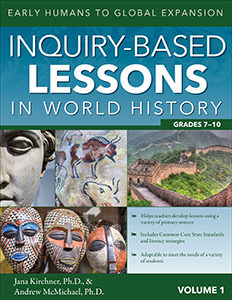Inquiry-Based Lessons in Early World History
Inquiry-Based Lessons in World History, Volume 1: Early Humans to Global Expansion
By Jana Kirchner, Ph.D. and Andrew McMichael, Ph.D.
(Prufrock Press, 2019 – Learn more)

“Beach Time!” That’s what most teachers were contemplating a few days or weeks ago as grades went into computers and rooms were cleaned and closed.
I too, have been cleaning and saying goodbye to students. However, as much as I want to think about having my morning coffee in the garden and long walks along our nature paths, I always do one more thing. I start my hunt for new ideas for next year.

The introduction gives an overview of the book. The authors state that “this book has a truly global focus meant to help teachers and students discover topical links in cultures around the world.” (p. 2) To help further with planning for the year, they’ve also made sure to have clear titles and chronology so we can find things quickly.
Tracking themes through civilizations
The topical links are important themes that are common in all cultures, like religion, government, geography, culture, art, technology and economics. By repeatedly discussing these connections among civilizations, the book can deepen learning and greatly enhance student memory and recall of the material.
The framework Kirchner and McMichael use for inquiry is the NCSS College, Career and Civic Life Framework (C3) with the inquiry arc focus at its core. Their lessons are designed to follow the scope and sequence of most middle school and high school texts. They also use the world history standards from the National Center for History in the Schools (NCHS, 1996).
The book is divided into four main timeframes:
Part 1 – Early Humans: beginning 15000 BCE
Part 2 – The Ancient World: 2500-0 BCE
Part 3 – Classical Antiquity: 0-750
Part 4 – The World in Transition: 750-1500
Within each timeframe there are different chapters such as:
The Neolithic Era and Early Settlements
Accomplishments and Achievements of Early Civilizations
Rise and Fall of Empires
Kingdoms of Europe
Resource rich chapters
Each of the chapters gives a page or two of the historical background information that will be helpful for a teacher to know, along with standards covered. Each chapter contains two to three lessons.
These lessons include a broad organizing/essential question, strategies used (like map analysis or role-play), and the materials needed to complete the activity. It is within these lessons that “Thinking Like a Historian” strategies come into play with the use of multiple primary and secondary sources. The students are then required to analyze these sources, formulate a thesis statement or hypothesis, and then support it with evidence.
The actual lesson plan is set up with:
• A lesson hook. This might be having the students do a notice and wonder of artwork from the period or a quick write of details found on a map.
• The organizing question.
• Examination of resources. This is where we find out how to use the materials. One lesson on the Ancient African Kingdom of Mali suggested putting the maps, travel account, and photos and textbooks around the room as clue stations. Students travel from station to station analyzing the materials.
• Creation of a hypothesis. Going back to their seats, students try to form an answer for the organizing question using evidence they have gathered to back up their theories.
In addition, there are many primary source handouts, and the authors also give search tips for finding more. A few of the lessons give optional extension activities.
I really enjoyed this book. As I was reading it and writing this review, I was also making notes in my plan book for next year!
Joanne Bell is a middle school teacher at St. Joseph Elementary School in Cottleville, Missouri. She currently teaches social studies to sixth and seventh graders and is working on a blog about ADHD titled http://thinkingthroughadhd.com/.



































Thanks for the review. I look forward to getting this book and begin my planning for this coming year.